Using the Bento
Using the Bento to make decisions.
How the Bento works
Building your Bento
Going deeper
The Bento for organizations

Practicing Bentoism
The Bento is a simple tool for making decisions aligned with our values and goals.

It's especially useful for “Should I” questions.
Moments when the path forward needs a closer look.
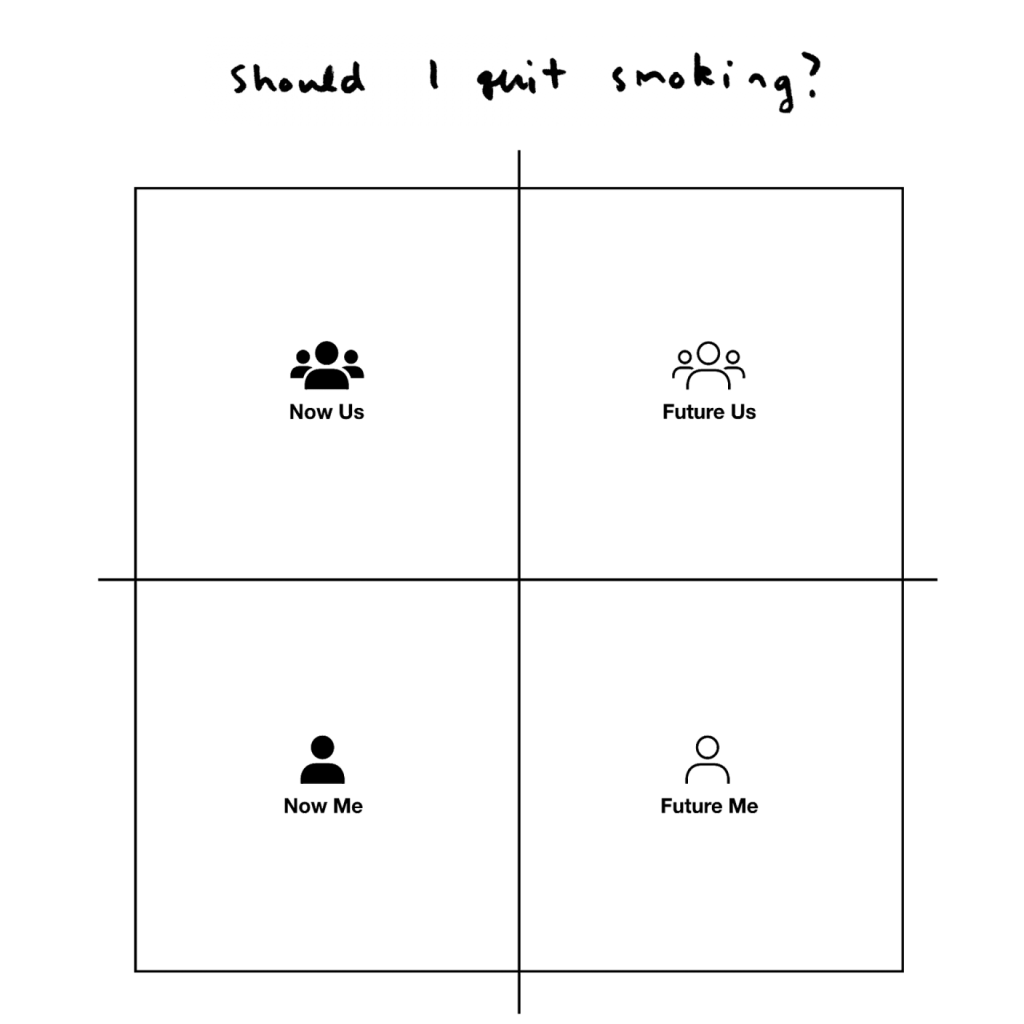
Let's use an example...
Imagine a smoker using the Bento to decide whether to quit smoking.
To do this, they ask each box for its unique perspective.
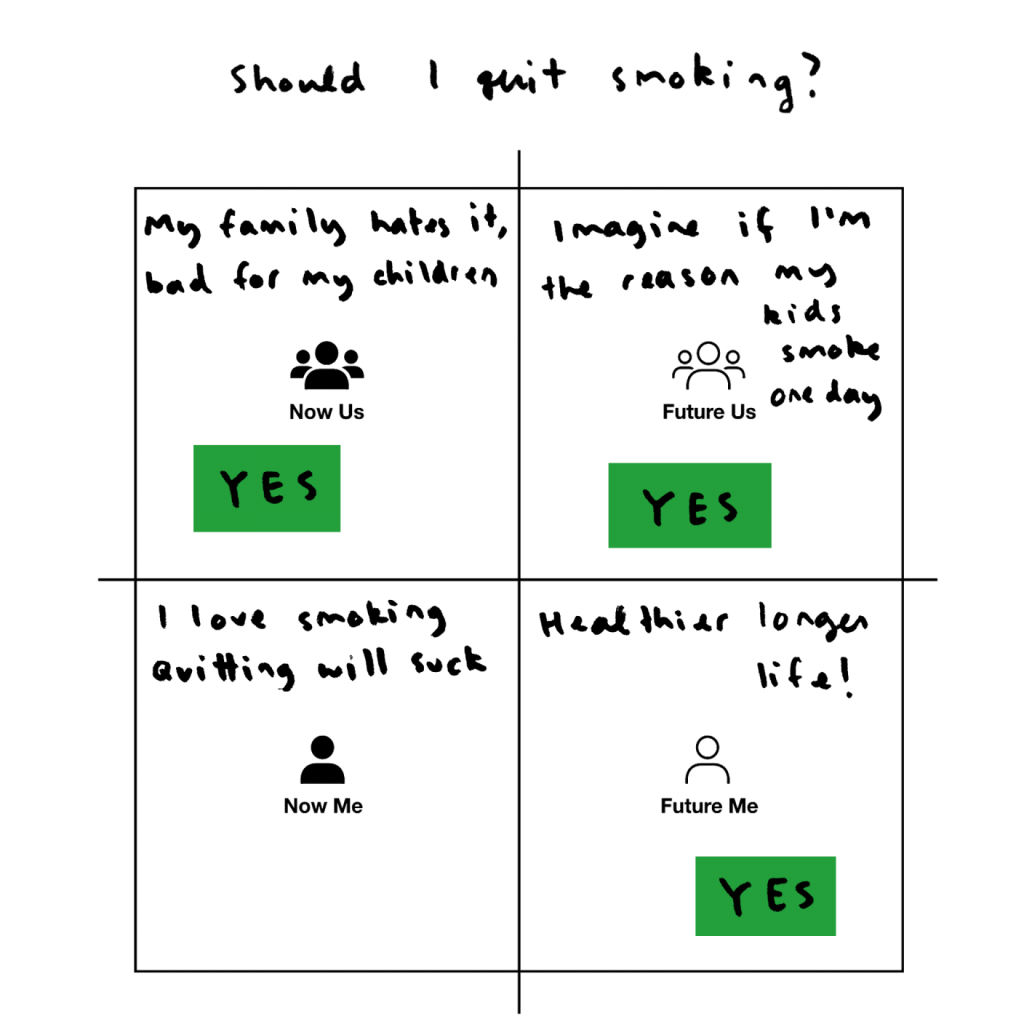
The smoker's Now Us, Future Us, and Future Me voices say “YES, quit!”
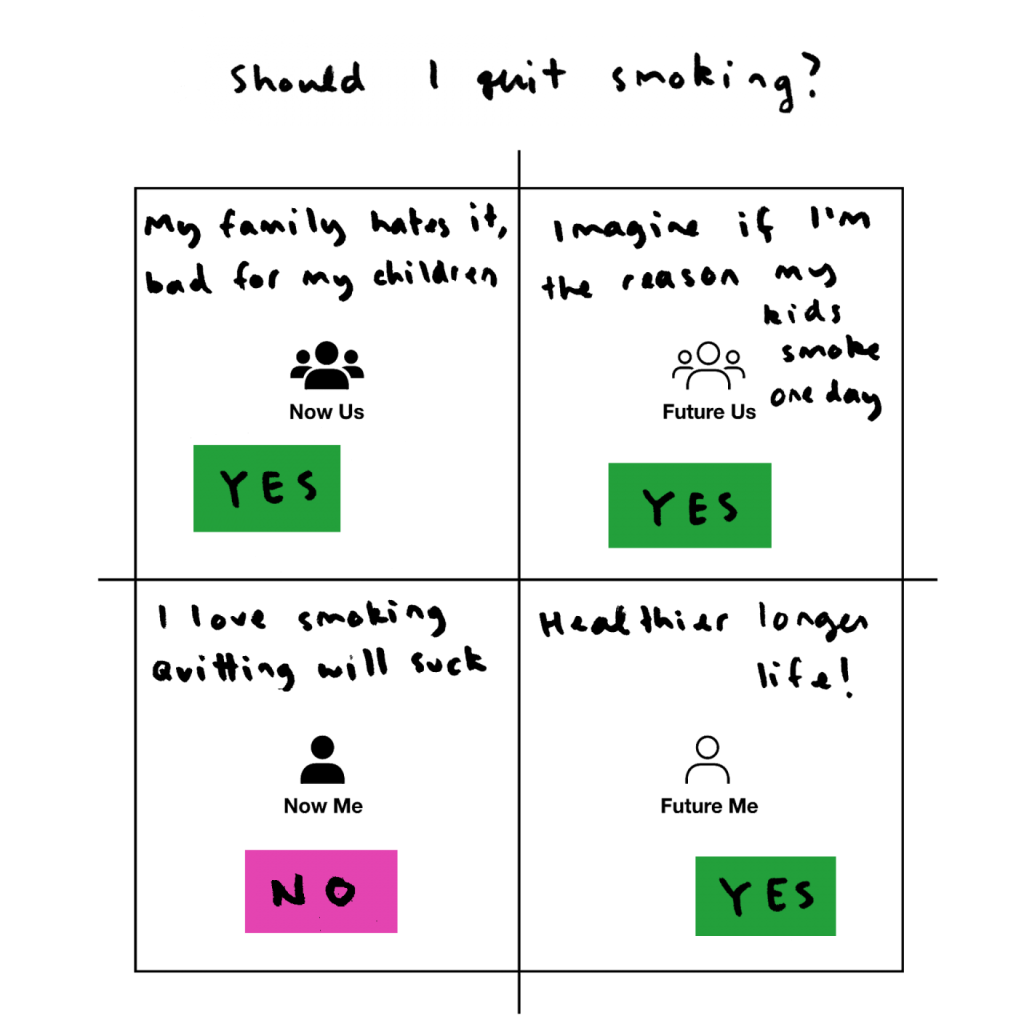
But the smoker’s Now Me? It says “NO: keep smoking.”
It’s not wrong. Now Me is addicted to nicotine. Quitting will suck. Who would choose such a thing?
Not an easy voice to reason with.
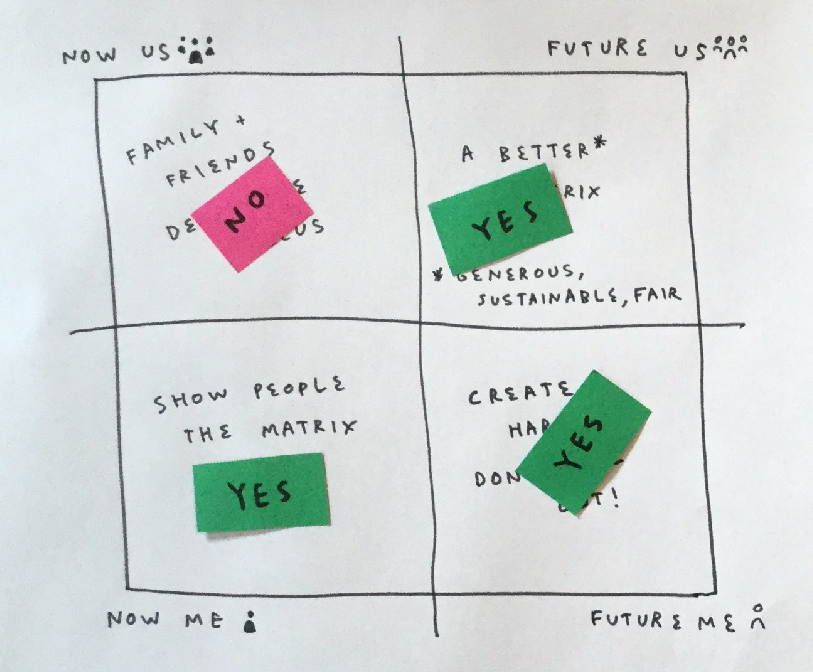
The Bento helps us understand the internal battles we all struggle with.
The Bento might not always resolve the issue. But it will create a more nuanced understanding of what's actually going on. Here are some common examples:
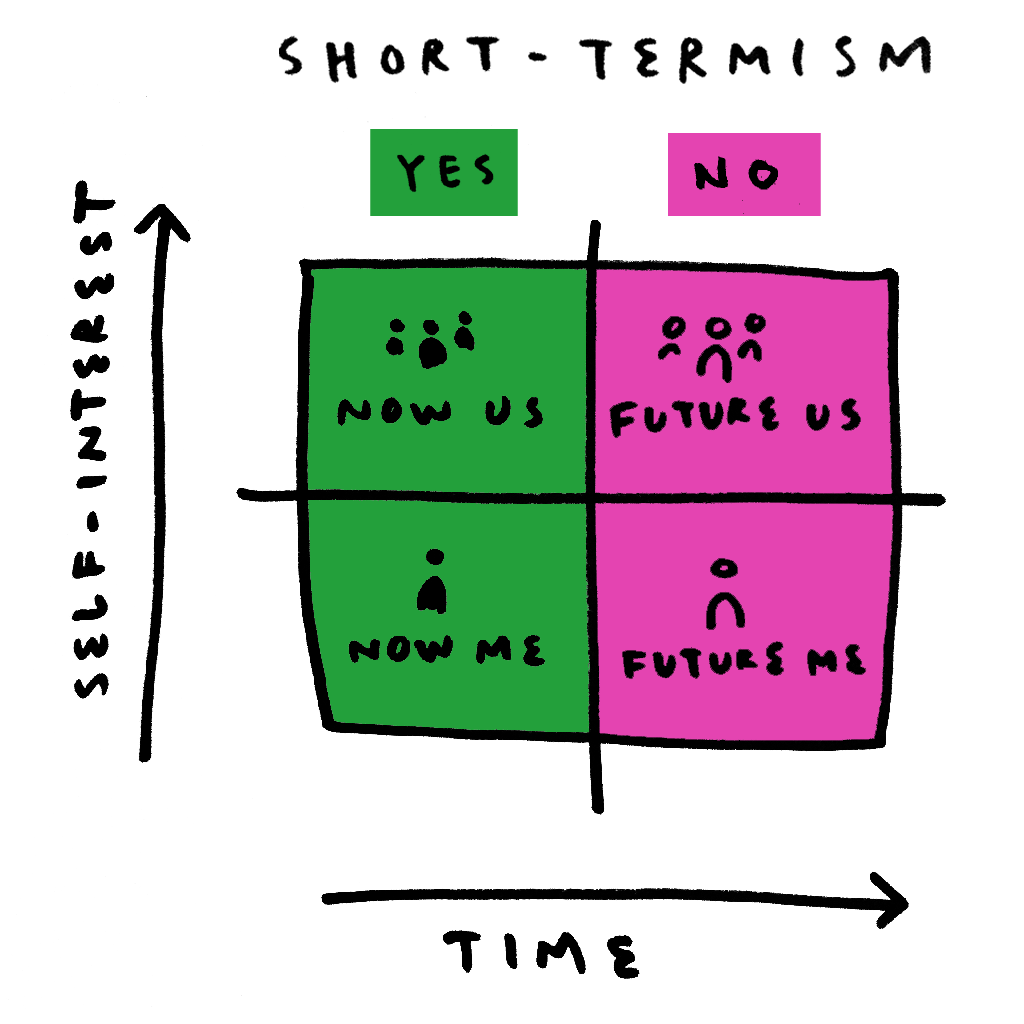
Type: Short-termism
Description: Something makes sense now but not over the long term
Response: Use the Bento to confront the long term implications. How does this decision look an hour from now? A year from now? The Bento creates a muscle memory for the long-term.
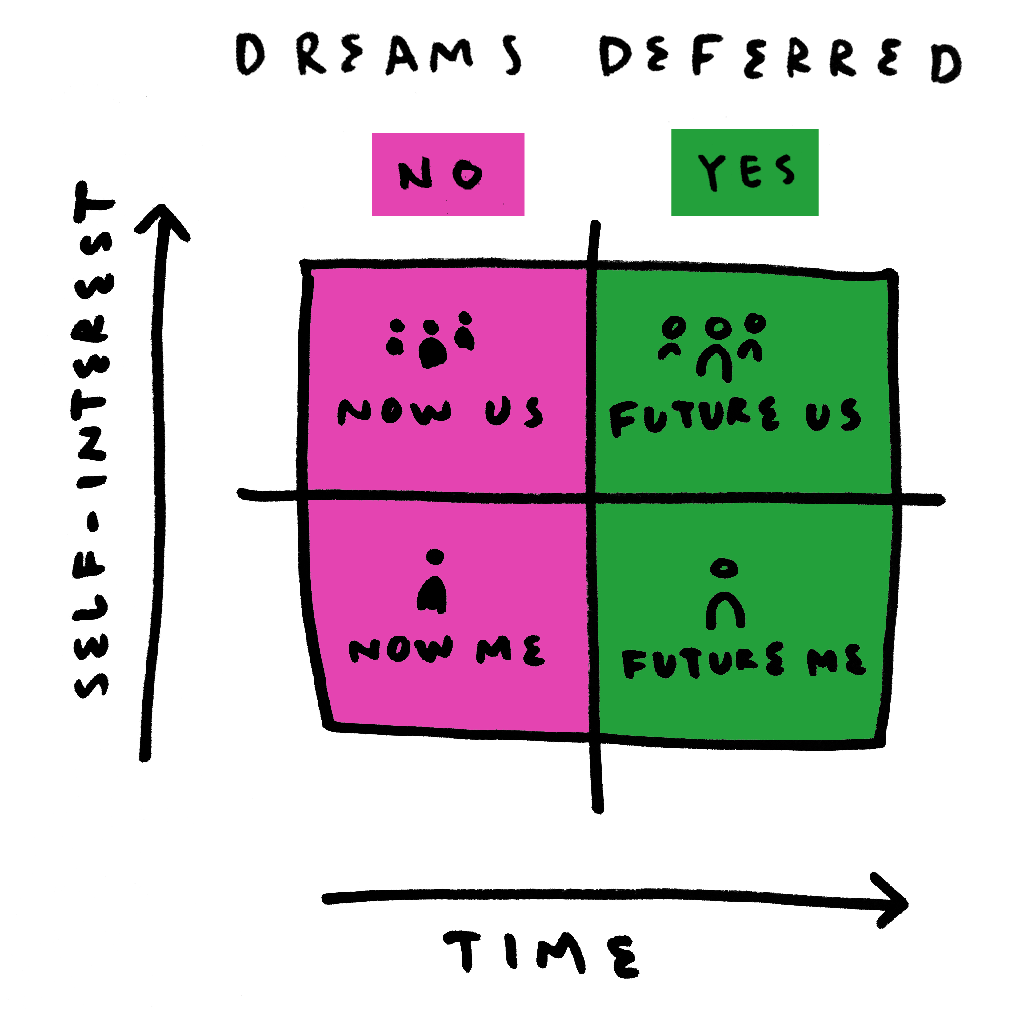
Type: Dreams deferred
Description: Current circumstances are delaying a bigger dream
Response: If not now, when? What does my Now Me need to say yes? A financial need? Permission? Be specific. OK, now what’s the path to changing that? How a dream becomes real.

Type: Values misalignment
Description: Something’s off. You don’t feel settled. You can’t commit.
Response: What expectations or desires do you have for future self? Is something about Future Me threatened by a current course of action? Could you be holding onto an expectation that might need to change?
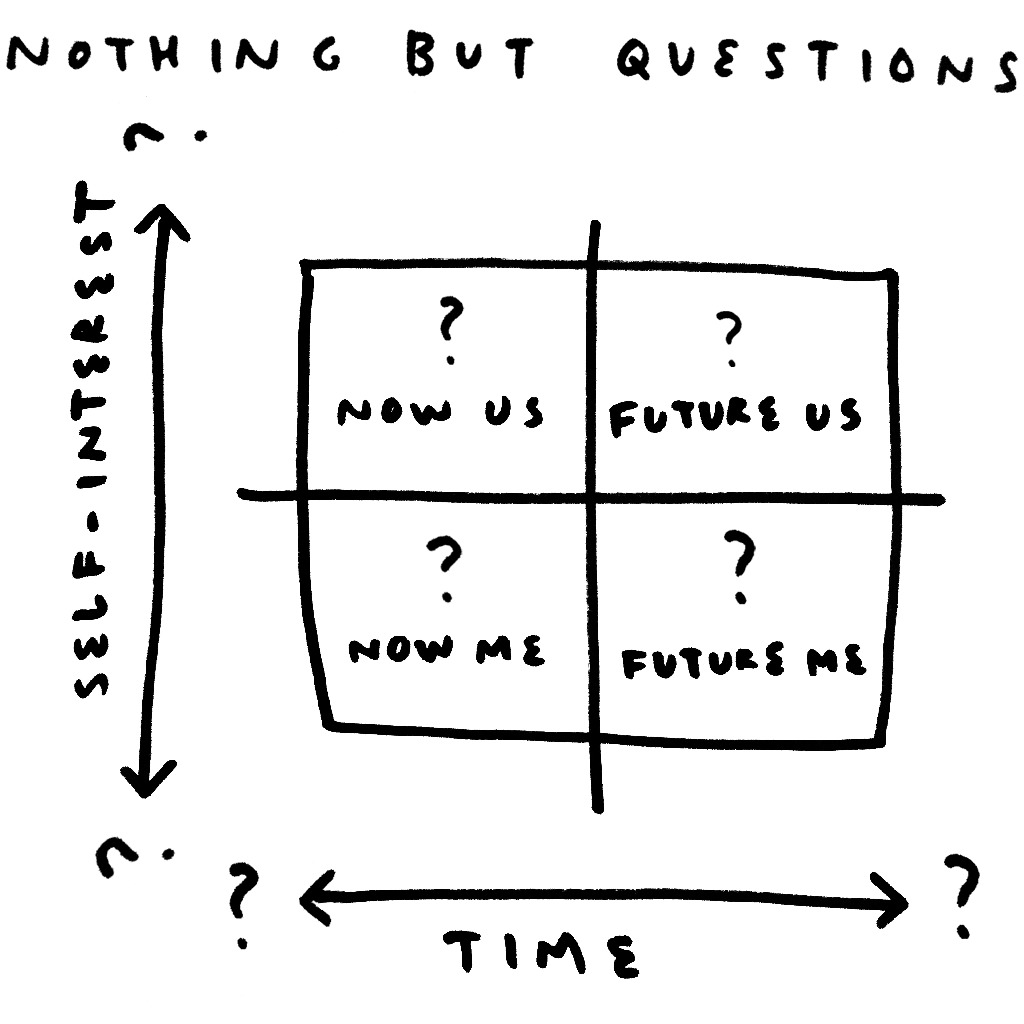
Type: Nothing but questions
Description: Without a purpose to guide you, every fork in the road provokes existential questions
Response: Develop your self-awareness using the Bento Method, and turn forks in the road into opportunities for growth and manifestation
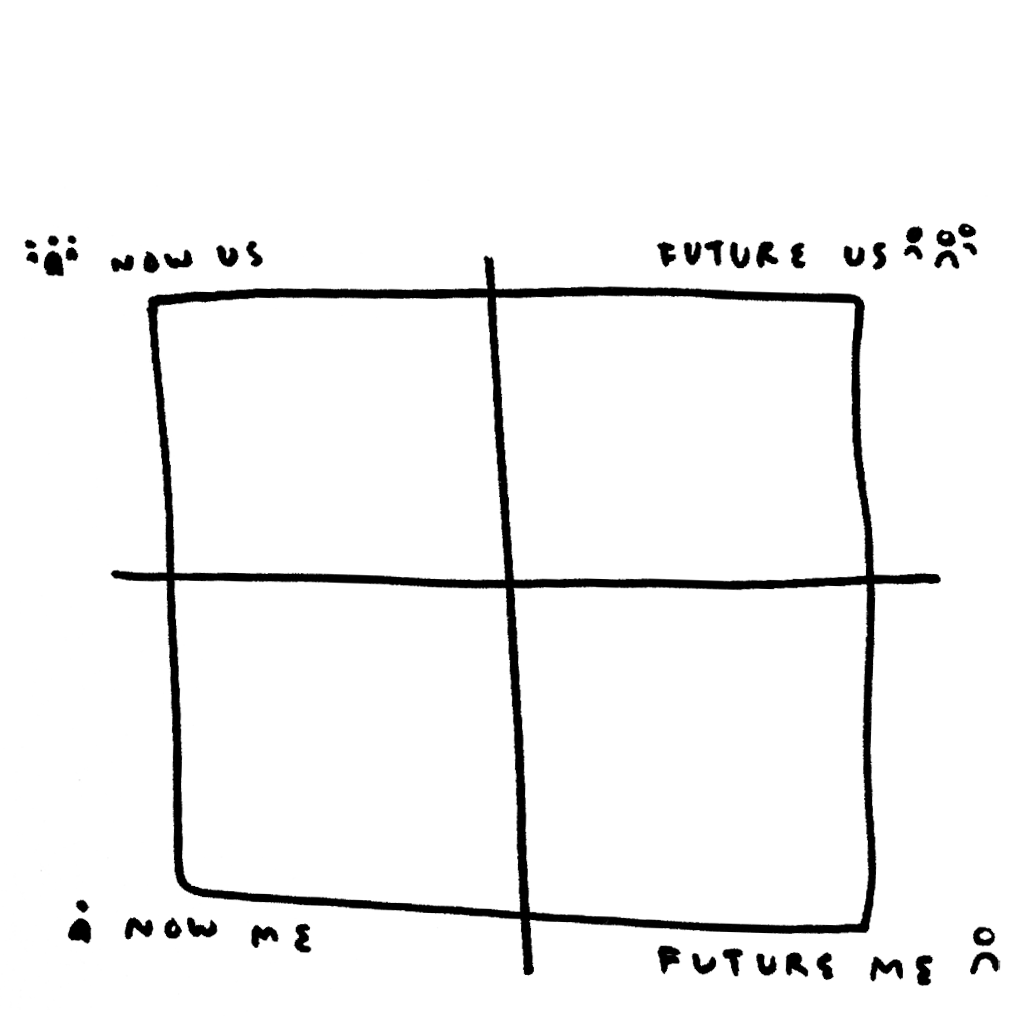
The Bento will help reveal the paths most aligned with who you are. When used as a daily discipline, the Bento can guide you towards an all-life flow state where your actions, values, and goals are working together.
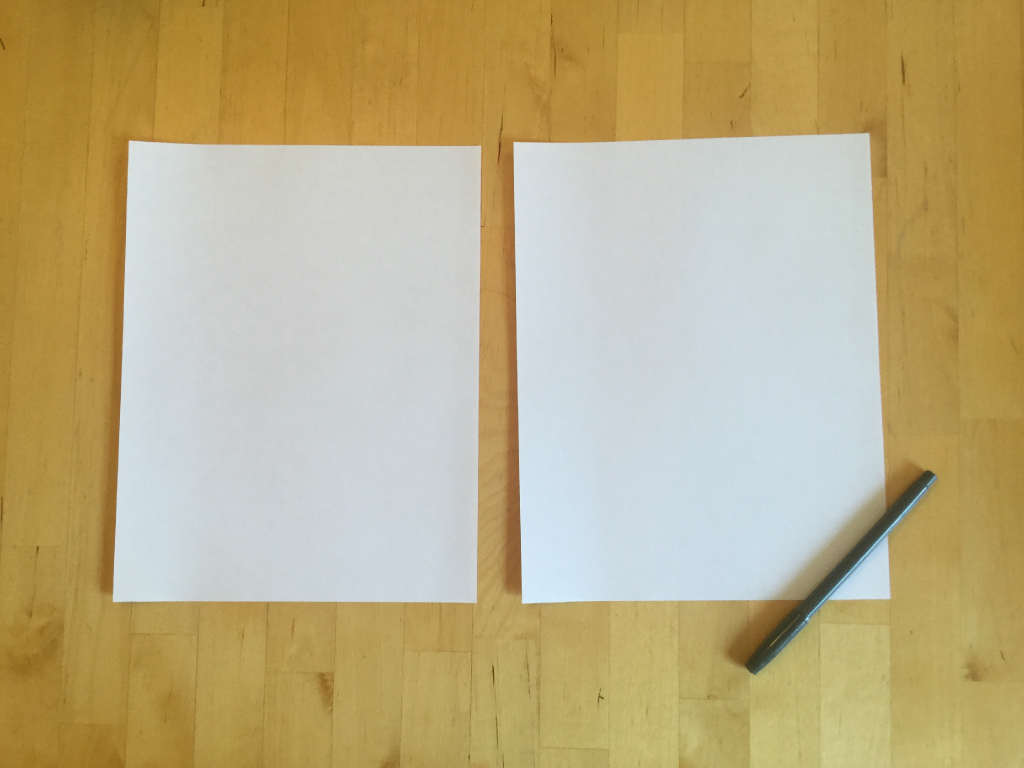
Building your Bento
Now it's time to build your Bento. This involves identifying your own values, goals, and needs.
All you need are two pieces of paper, a writing implement, and fifteen minutes of your time.
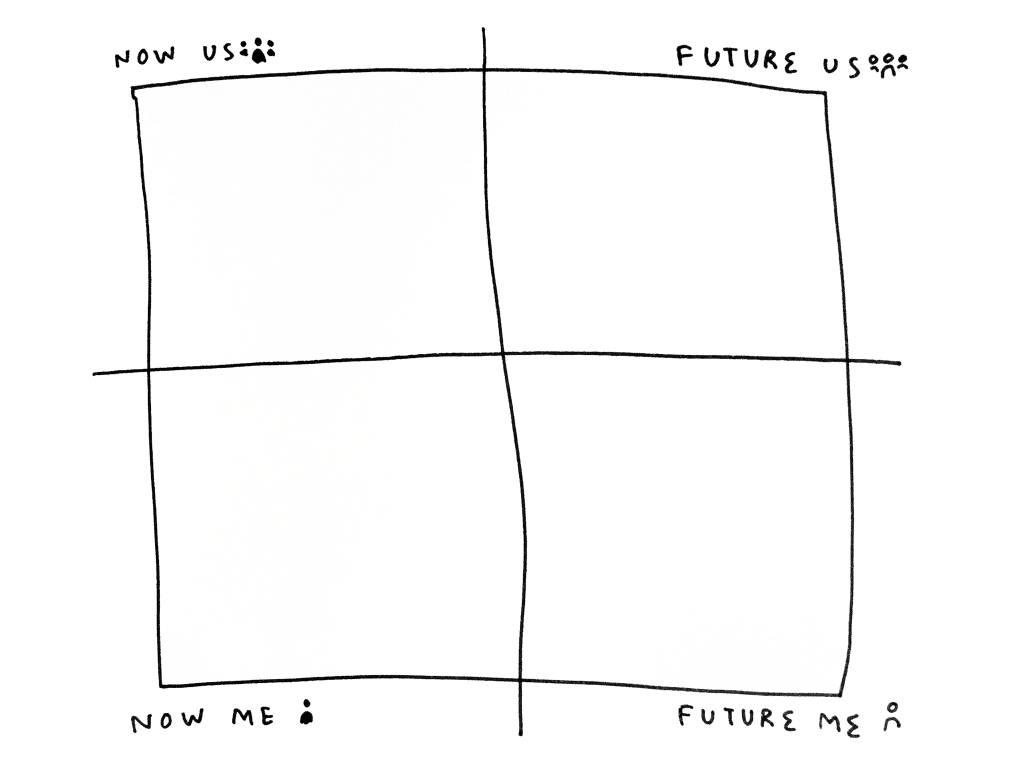
On both of these pages, draw a Bento and label each box, like this.
You can instead download and print two copies of this pre-made Bento page.
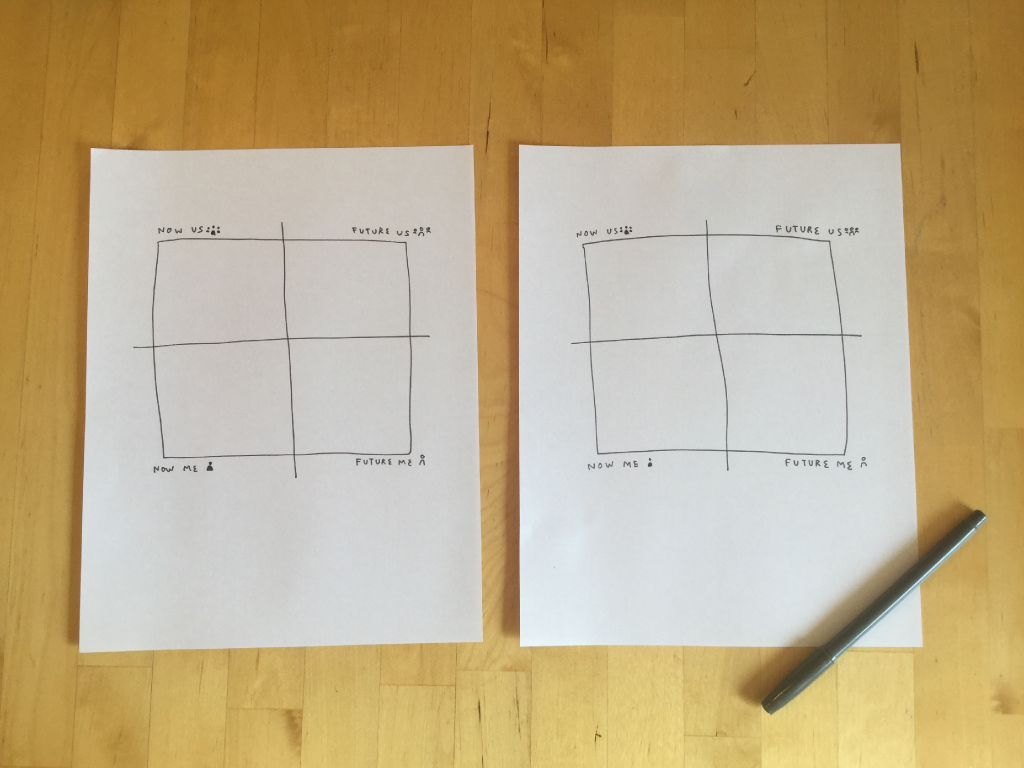
You now have two pieces of paper, each with a Bento. We’ll use one to start. Set aside the other for a bit later.

This is your first Bento (congrats!). We’re now going to fill it with your values, goals, and needs.
In the following steps, you’ll be given a series of simple prompts to be answered in each space of the Bento. Take about 90 seconds to write down everything that comes to mind in each one.

We’ll start with Now Me.
This is the most “selfish” part of you. The part that craves safety, pleasure, and autonomy.

What does Now Me want and need?
What do you need to feel secure? How do you provide for yourself? See some example answers to the left.
Take 90 seconds to write your answers in the Now Me box of your Bento.

Next is Future Me.
Future Me is the older, wiser version of yourself that lived up to their commitments and made all the right decisions. What do they say matters most in life for you?

What does Future Me want and need?
What must always be true of you? What would your obituary say about you? What drives you?
Take 90 seconds to write your answers in the Future Me box.

Next is Now Us.
Now Us are the people we rely on and who rely on us. Our families, neighbors, coworkers, people of the same faith, ethnicity, nationality, and so on.

What does Now Us need?
Picture your friends, family, coworkers, neighbors, and community. What do you give in your relationships with them? What do they give to you? What's at the heart of your relationships?
Take 90 seconds to write your answers in the Now Us box of your Bento.

Last is Future Us.
Future Us is the next generation. Our children and everybody else’s children too.

What does the next generation need?
What do your children (literal or figurative) need? What did previous generations leave for you? What should you leave for the next?
Take 90 seconds to write your answers in the Future Us box.

Your Bento should now look something like this.

The next step is to look for similarities and themes in each space.
Circle, underline, and highlight whatever stands out. What underlying themes emerge?
Take 90 seconds.
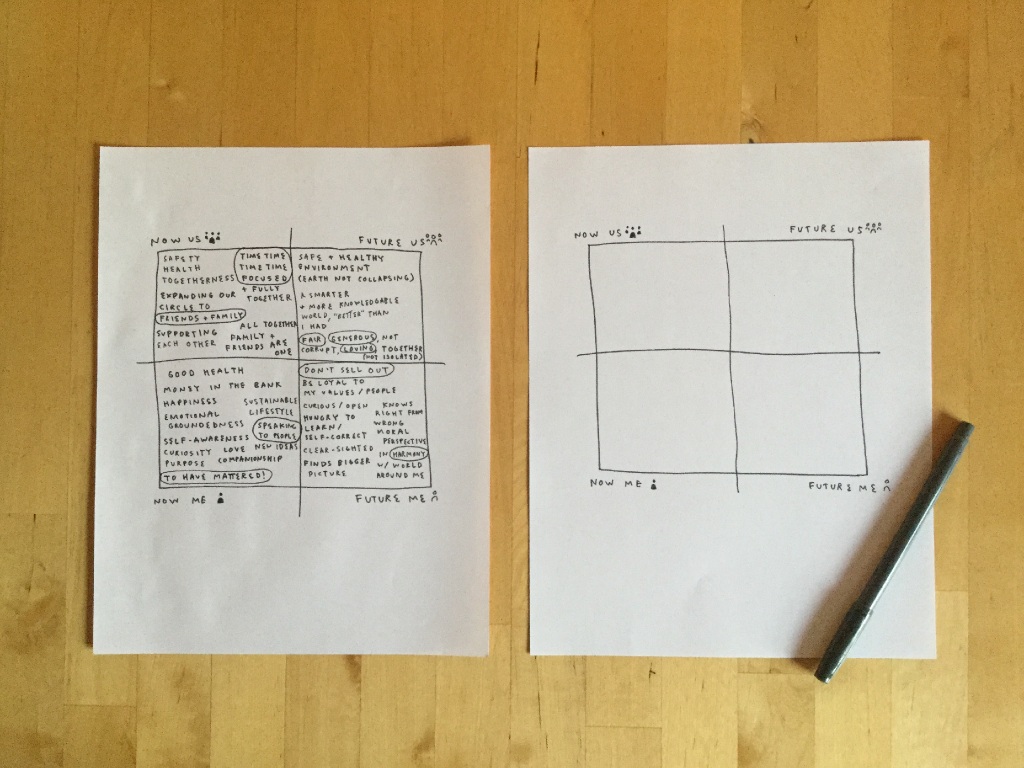
Finally, take out your second Bento (or download and print this one).

Sum up the themes that emerged in each part of your Bento in a simple phrase. Four words or less is ideal.
Take three minutes to come up with the right phrases. Once you have them, write them on the blank Bento.
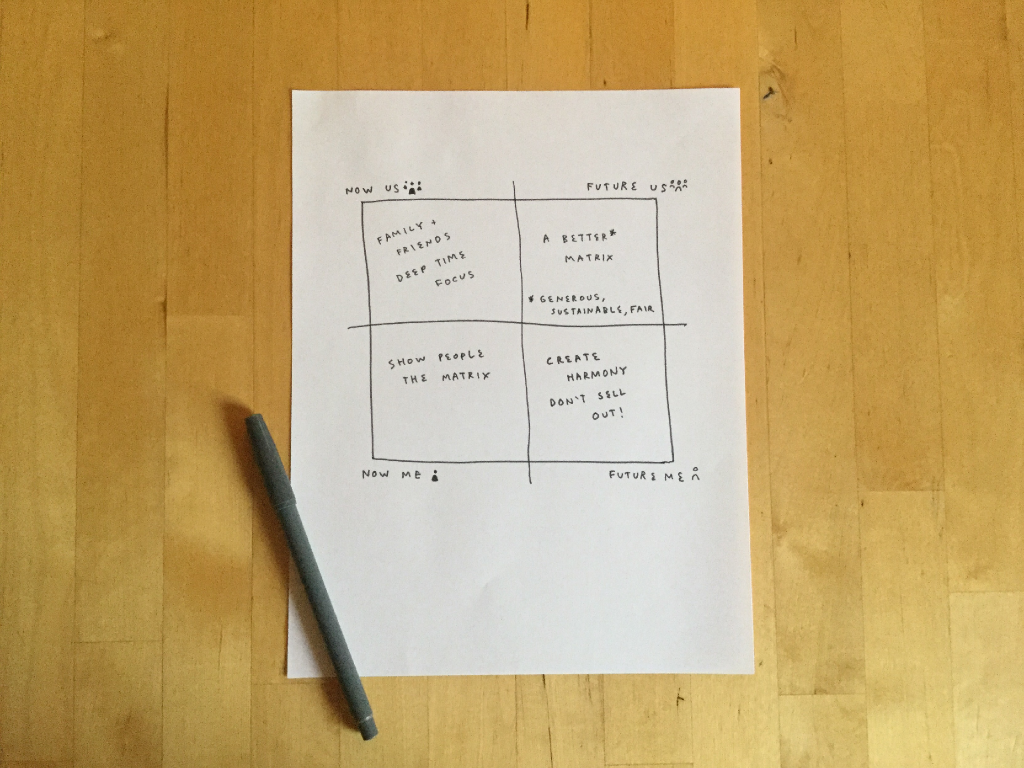
This is your Bento. Your personal roadmap for self-coherence. Keep it next to your desk or as the lockscreen on your phone. Use it as your compass when making decisions and prioritizing your time.
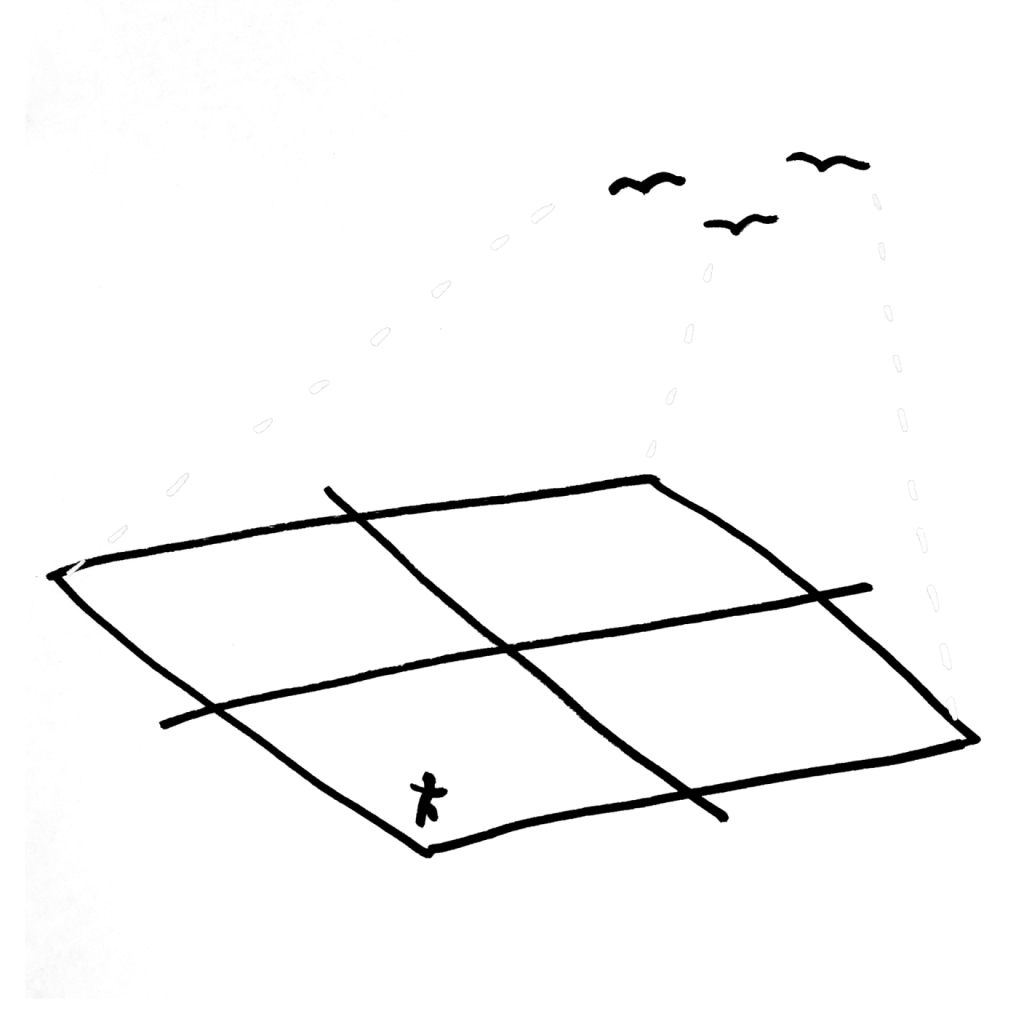
Next steps
Say you're into the idea, you've made your Bento, and now you want to go deeper. What should you do?
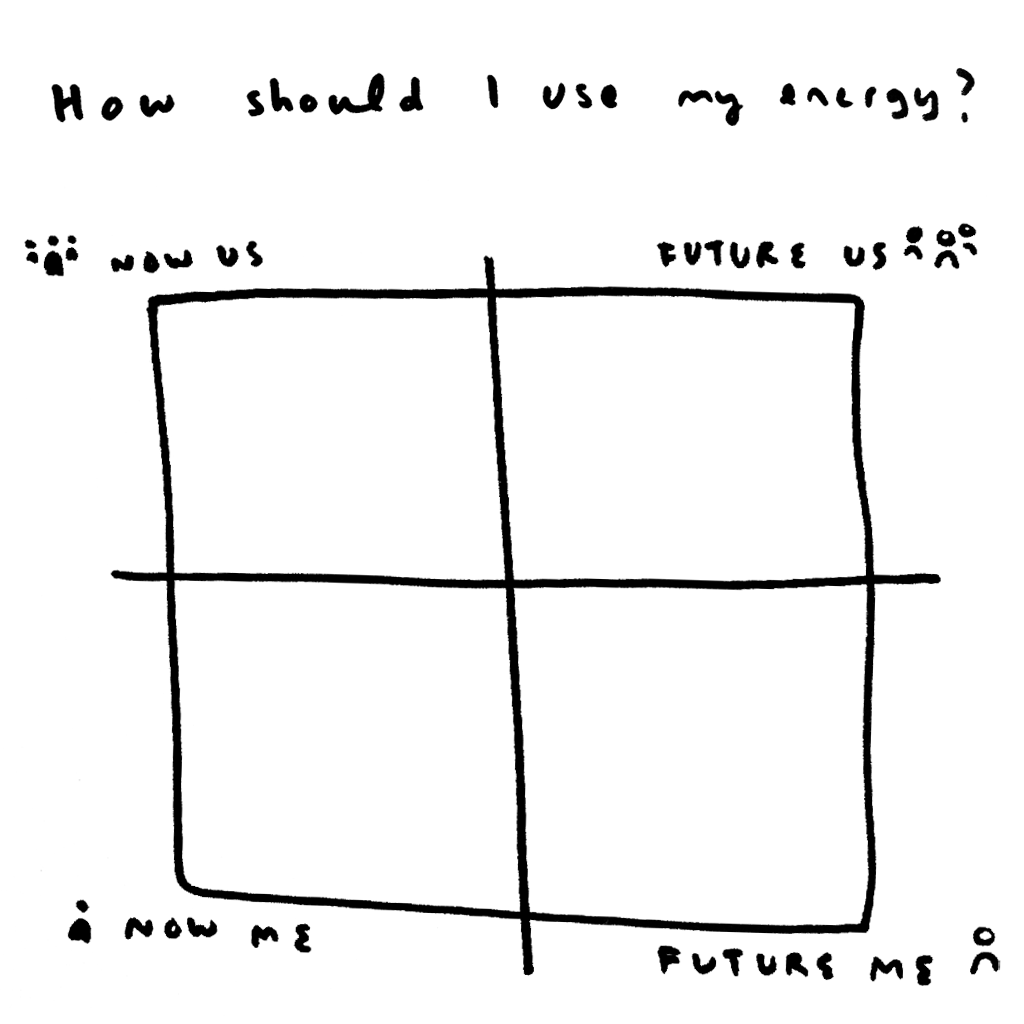
The recommended place to start is by creating a Weekly Bento practice.
On Sunday mornings you set your weekly priorities using the dimensions of the Bento.
After drawing a Bento like this one...

You ask each box what to do that week. Each will have its own perspective.
Now Me: tasks, errands, and work
Now Us: people to make time for
Future Me: your long-term commitments
Future Us: concrete steps towards the big picture
This becomes your weekly to-do list.
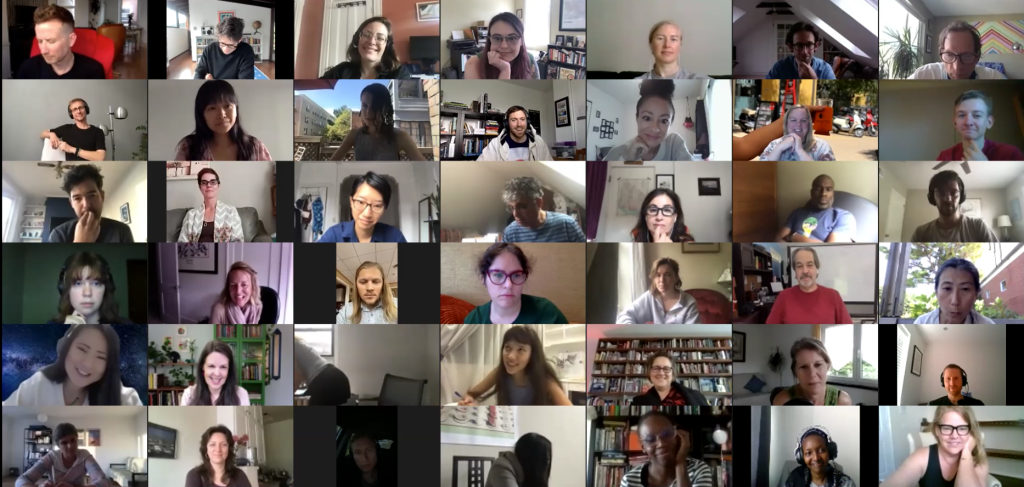
The Weekly Bento is also a group experience.
Every Sunday at 12pm EST, people gather on Zoom from around the world to set their priorities together.
Sign up to join one of these sessions here.
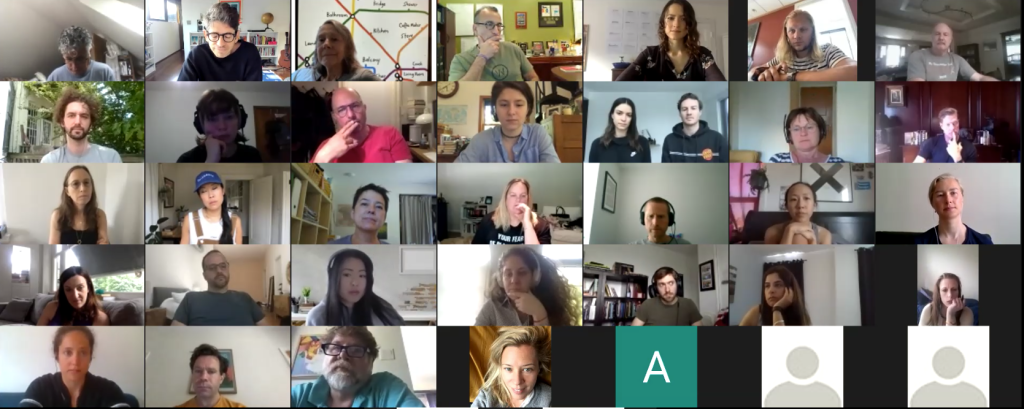
We call ourselves The Bento Society. We come from all over the world and every walk of life.
There are retail workers and artists. Students and professors. CEOs and customer service workers. Health care workers and filmmakers. Scientists and Uber drivers.
We're brought together by a commitment to be more than Now Me.
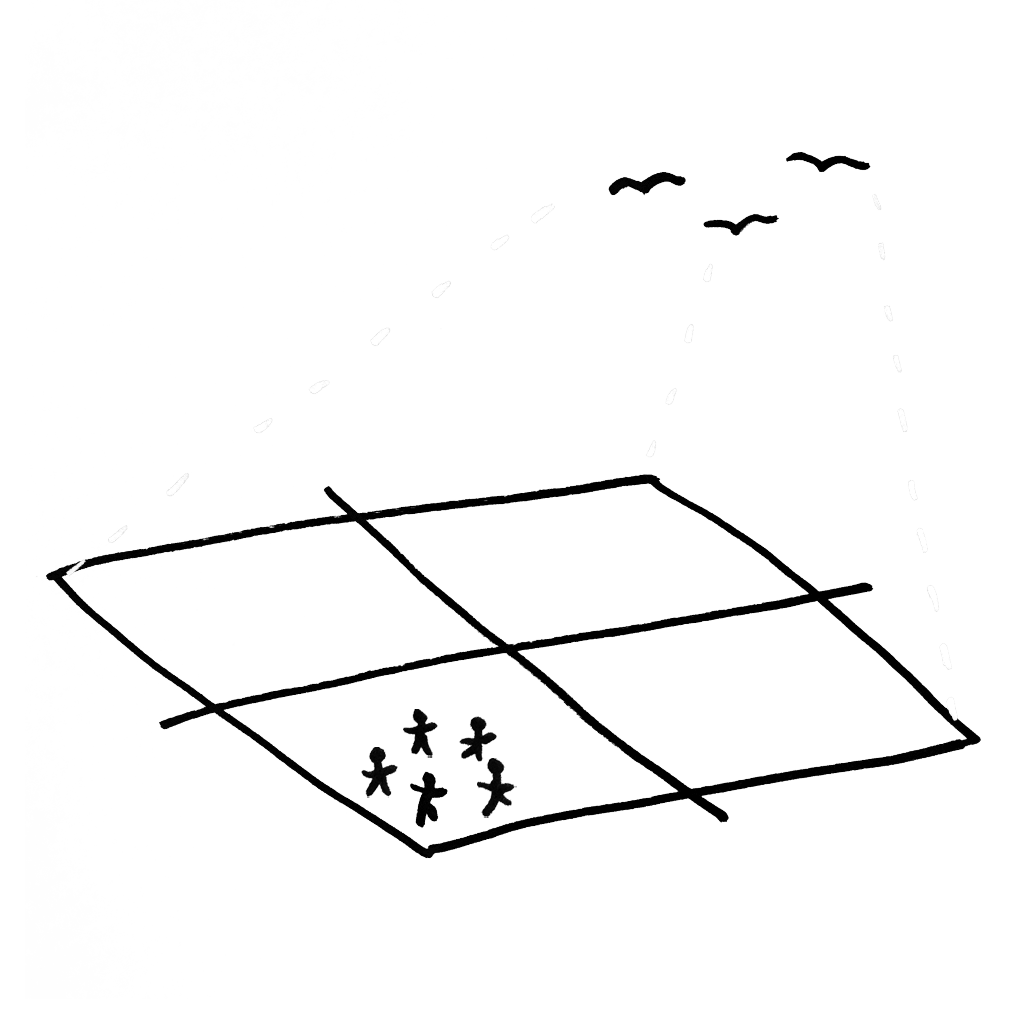
The Bento Society’s thirty-year mission is to redefine what the world sees as valuable and in its self-interest.
This starts with us as individuals. It will expand to the communities we're part of. And as society passes the baton to the next generation, the Bento will become the new default for how everyone sees self-interest. Different choices and outcomes will naturally result when it does.
There's a ways to go yet. We've only just begun.
If you'd like to join the Bento Society and our community, we're thrilled to hear it. You can learn more about us here.
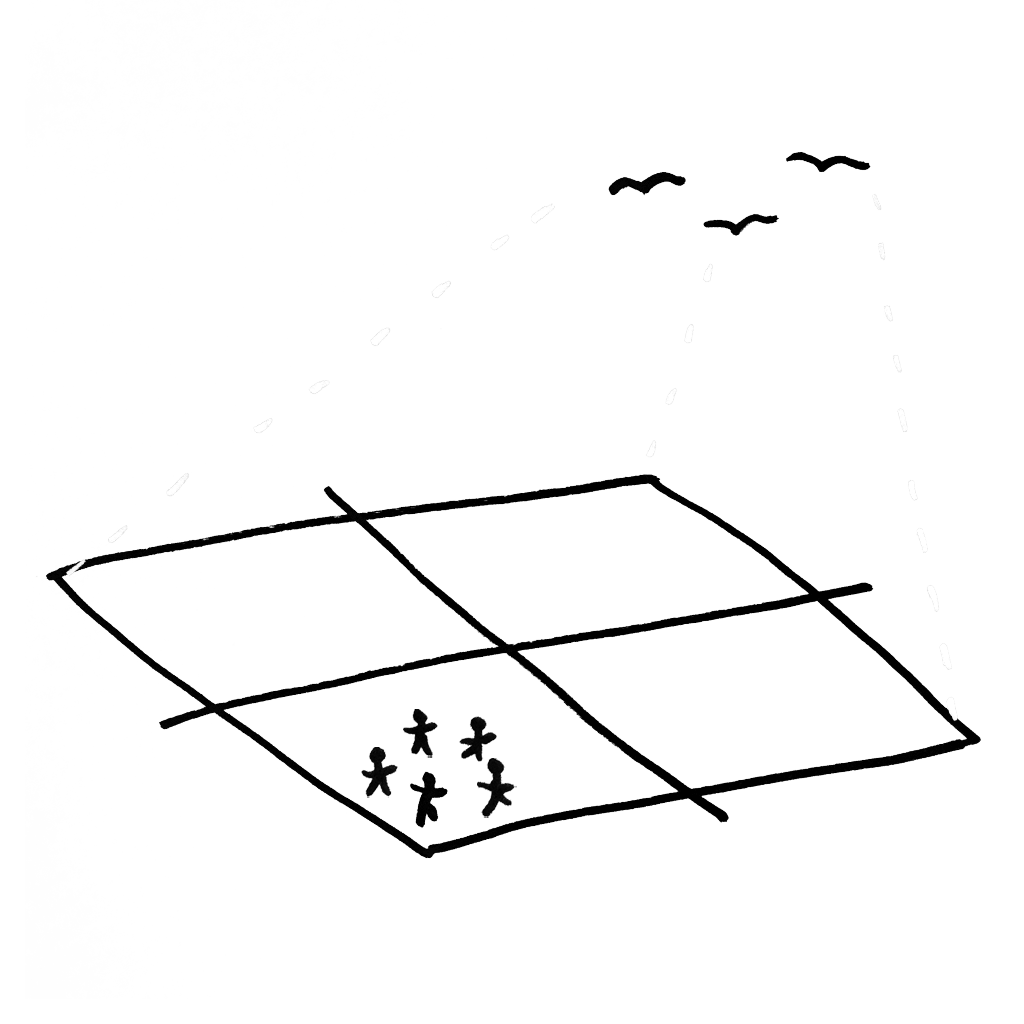
The Bento for organizations
The Bento was originally created as a way to help the needs and challenges of organizations.
It can help any organization fulfill its mission, live up to its values, meet the needs of its stakeholders, and manifest its larger vision in the world.
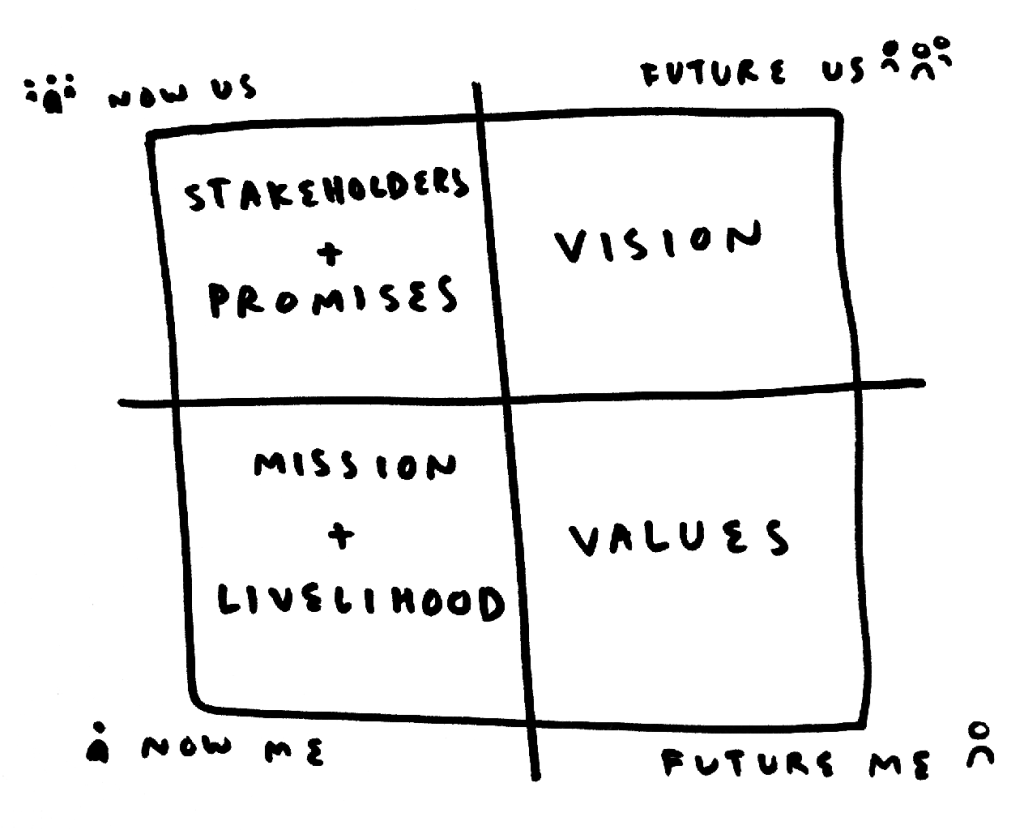
The first step to using the Bento as an organization (aside the million meetings and approvals) is to map your existing mission and values to the Bento structure.
These are all things your organization should already know. They're also things people often get confused about, so let's go through them one by one.
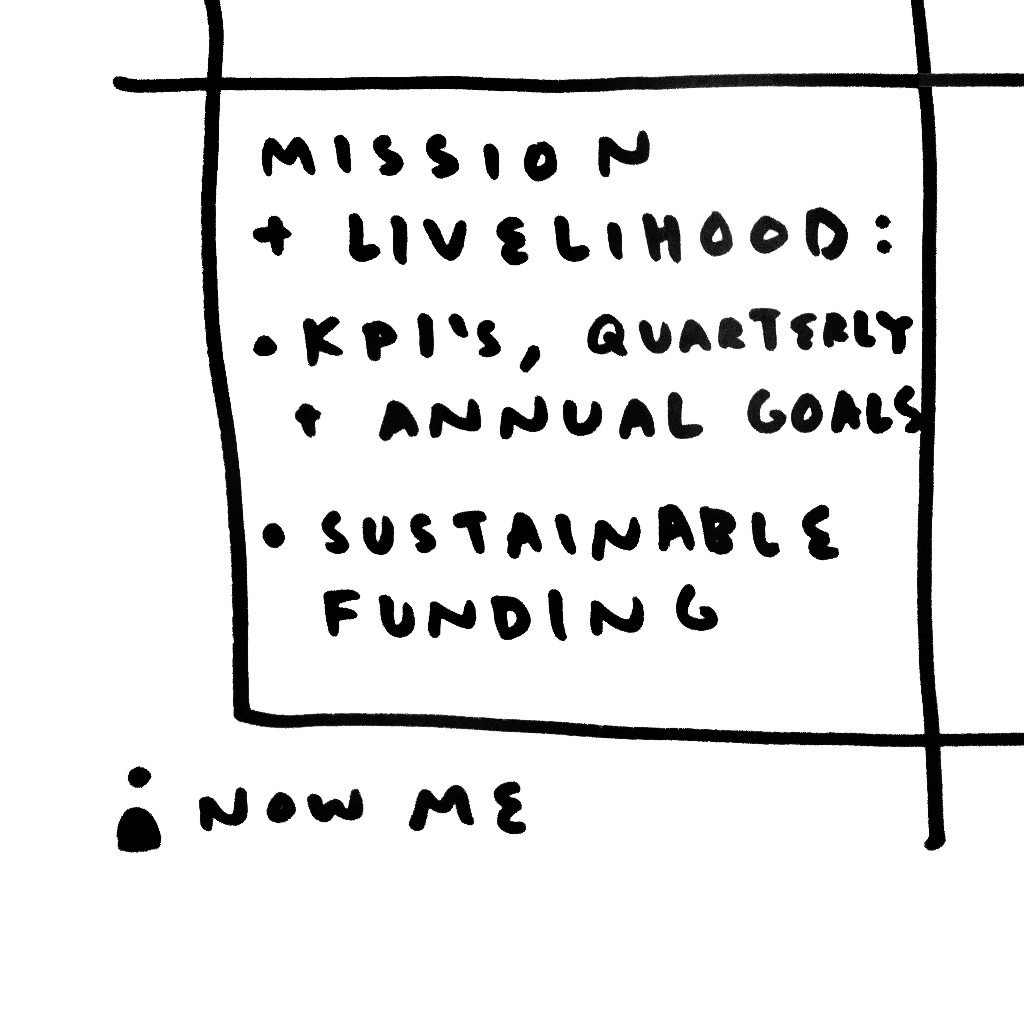
Now Me represents your mission and livelihood
The daily actions you take to fulfill your mission, as well as how you support yourself.
These things are critical. Without them you don't have an organization. But they're also not the whole picture.
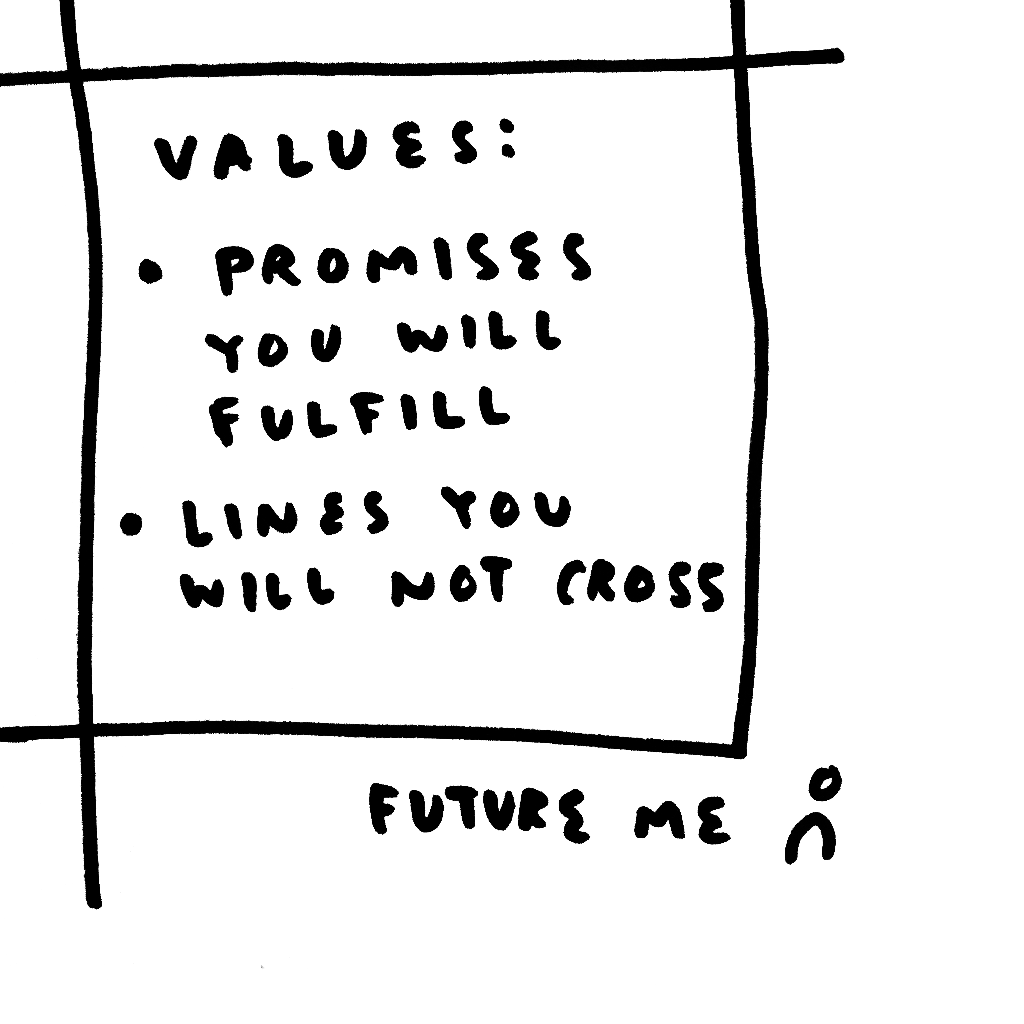
Future Me is your organization’s values. The best-case version of yourself that you’re always trying to live up to.
These are often expressed in an idealized form, like a brand promise, e.g. “Think Different,” “Just Do It,” etc.
To fulfill the expectations it set, an organization’s actions must meet this Future Me ideal from that point forward.
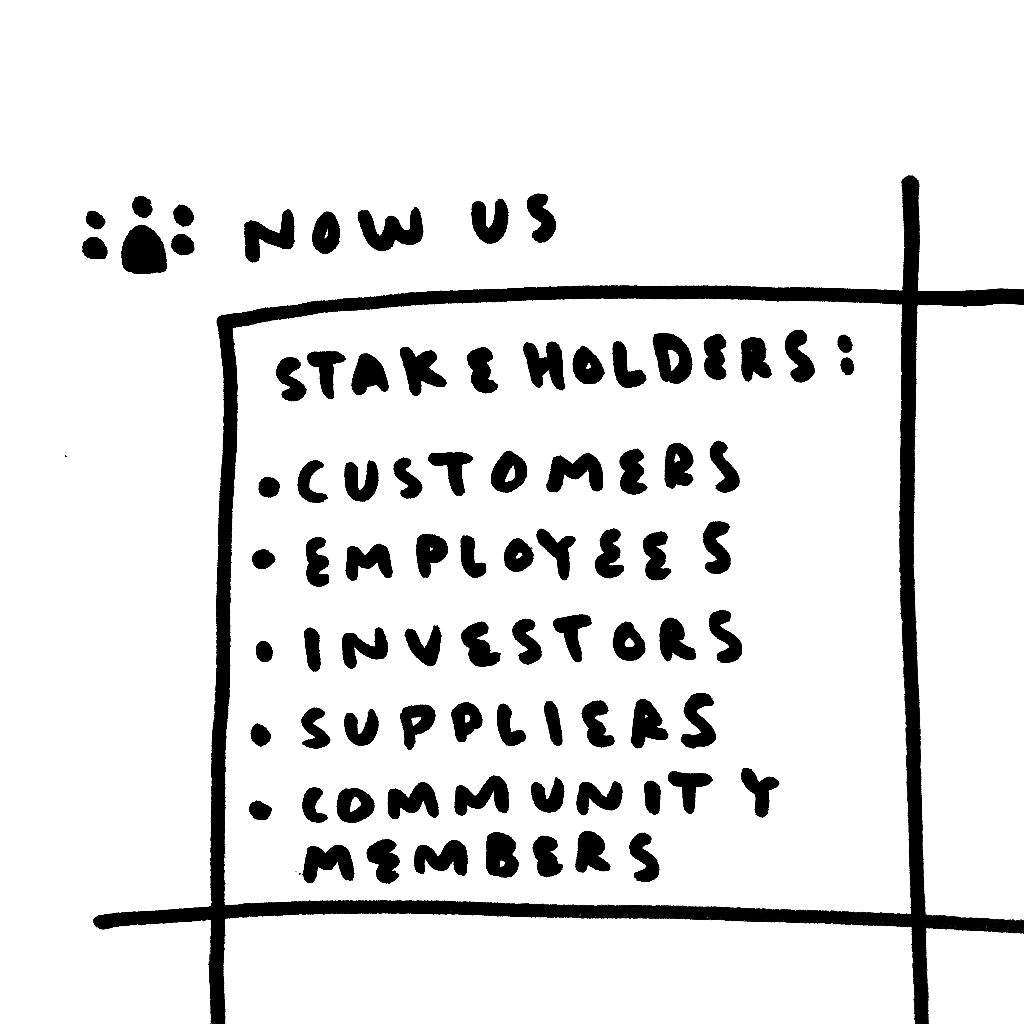
Now Us are your stakeholders: your customers, employees, partners, suppliers, funders, investors, the physical and professional communities where you operate.
For each of those groups there are promises that every organization makes and must live up to. To be a reliable employer. A good community member. A profitable endeavor.
To be healthy, an organization must always fulfill these promises.
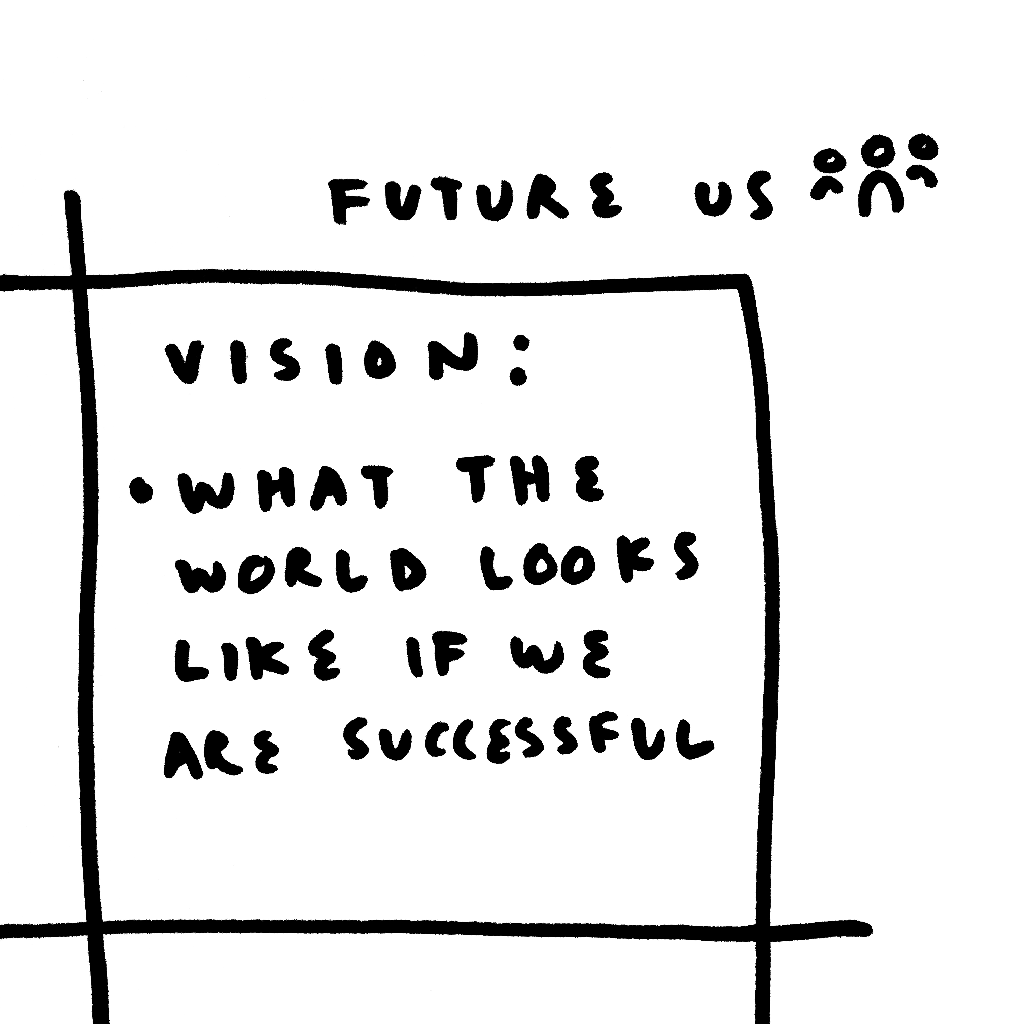
Future Us represents your larger vision. What the world looks like when your mission is successful.
A well-defined Future Us is a gravitational force that pulls decisions and priorities in its direction.
Microsoft’s “a computer on every desktop” is a great example.

Once your mission, livelihood, values, stakeholders, and vision are there, the Bento becomes your compass for decision making.
Which project is more “us”? Should we seize this opportunity or that one? Let's check with the Bento.
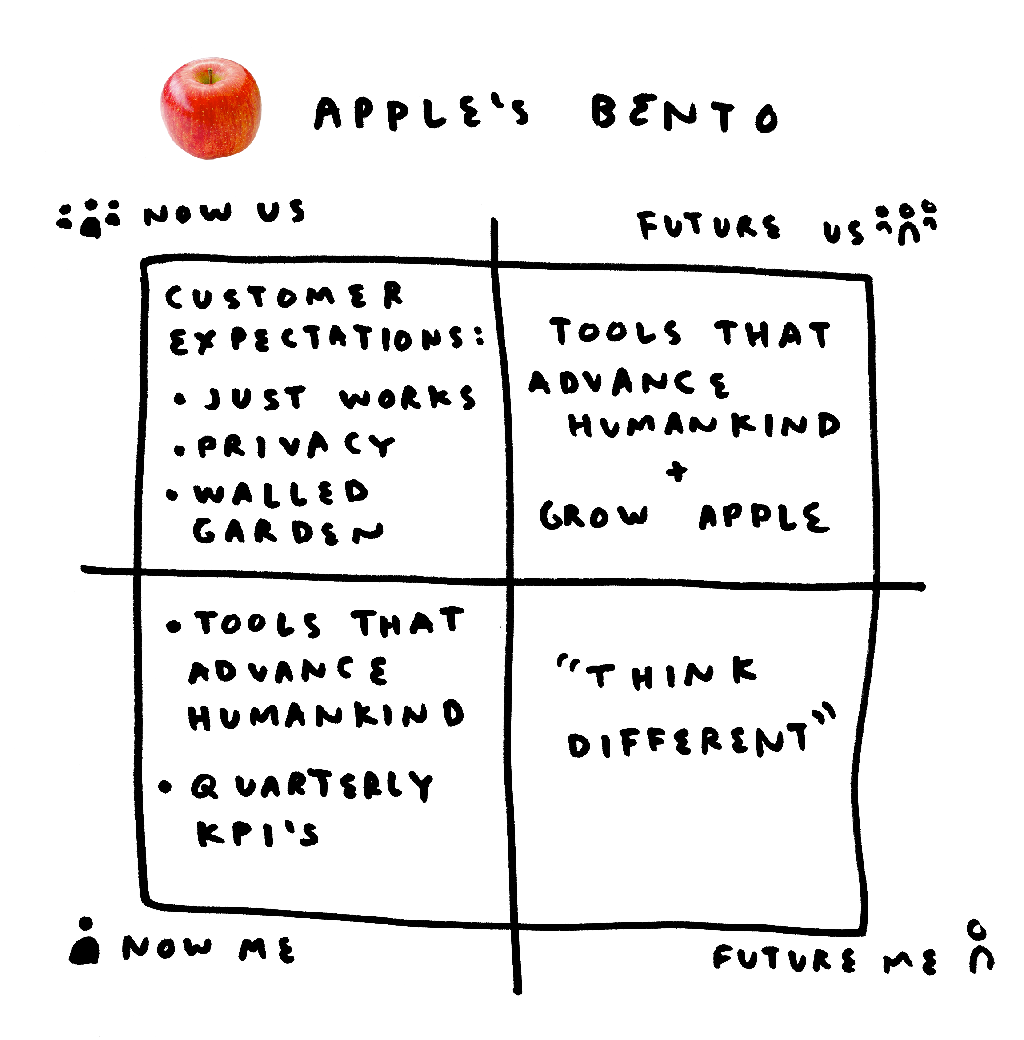
Let’s use an example.
Take Apple.
Here we've put Apple's actual mission statement, brand messaging, and product history to guess at what their Bento might look like.
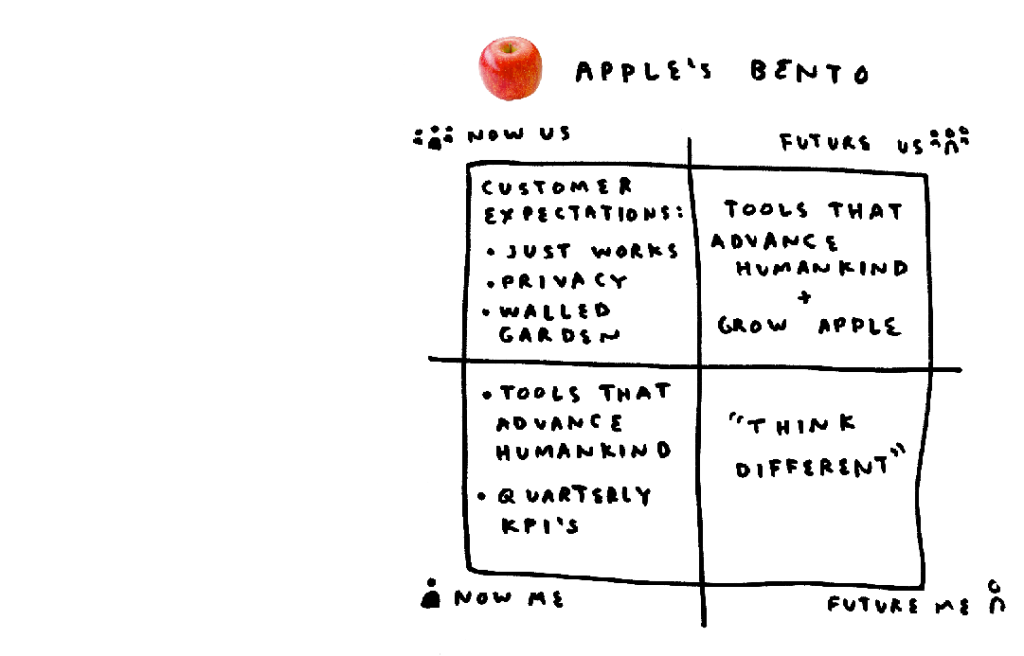
What's Apple's secret?
Its ability to fulfill its Future Me pledge to "think different" while also creating products that satisfy its customer promise to deliver tech that "just works."
To succeed, an Apple product can't have just one of these traits. It must have both, as we'll see.
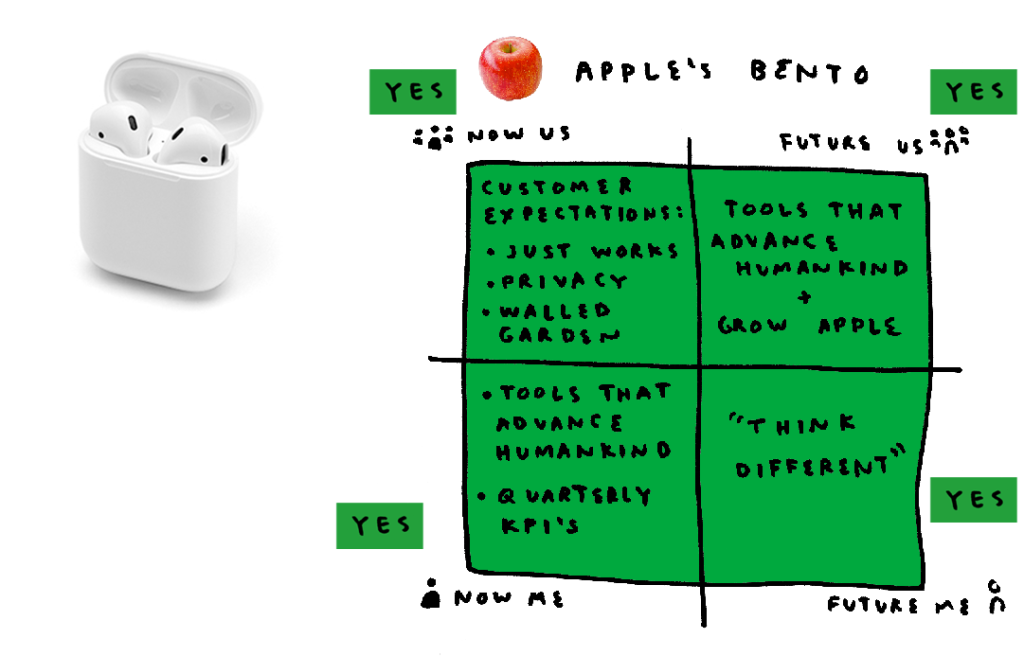
First, take the Airpods. They've been a huge success.
Their Bento shows us why.
They think different. They just work. They’re quintessentially Apple.
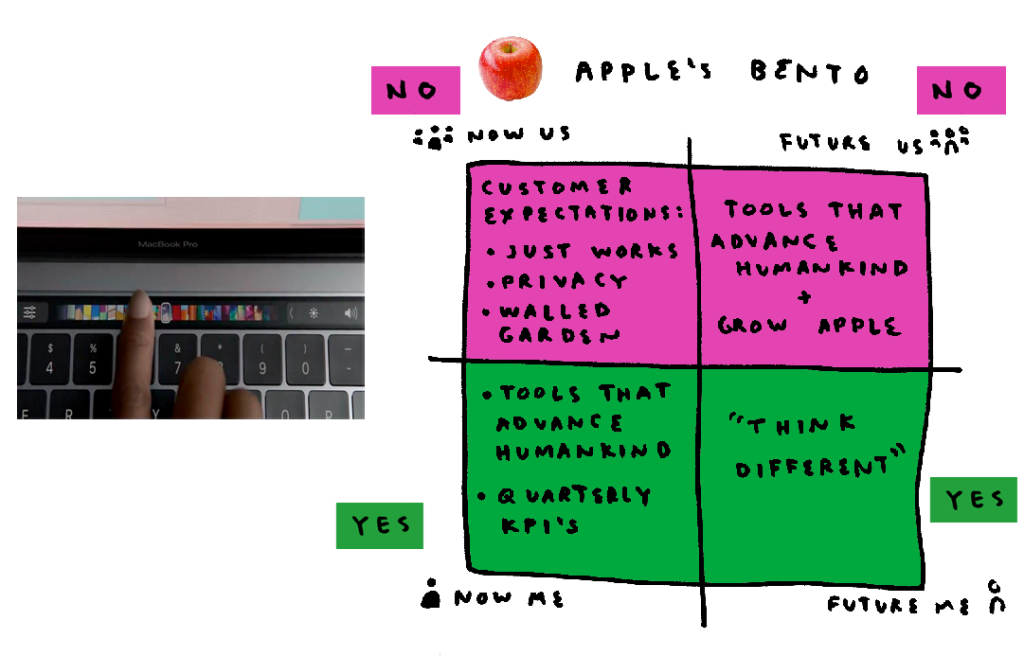
Compare that to the Apple Touchbar.
It thinks different. But it doesn’t just work. Reviews complained about its lack of functionality. It wasn’t Apple.
It failed.

Making decisions that are coherent — fully in integrity with who you are — is hard for even the best organizations to consistently do.
It’s also something that every organization can do by using the Bento.
If you’d like to go deeper with bringing the Bento to your organization, contact us here.
